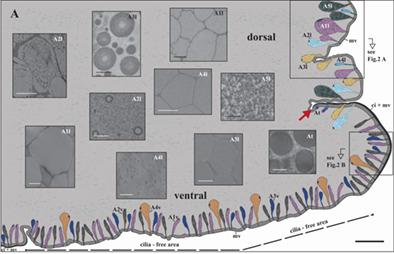当前位置:
X-MOL 学术
›
J. Morphol.
›
论文详情
Our official English website, www.x-mol.net, welcomes your
feedback! (Note: you will need to create a separate account there.)
Characterization of the Arion vulgaris pedal gland system
Journal of Morphology ( IF 1.5 ) Pub Date : 2020-07-10 , DOI: 10.1002/jmor.21231 Sophie Greistorfer 1 , Johannes Suppan 2 , Norbert Cyran 1 , Waltraud Klepal 1 , Robert Farkas 3 , Livia Rudoll 4 , Janek von Byern 1, 5
Journal of Morphology ( IF 1.5 ) Pub Date : 2020-07-10 , DOI: 10.1002/jmor.21231 Sophie Greistorfer 1 , Johannes Suppan 2 , Norbert Cyran 1 , Waltraud Klepal 1 , Robert Farkas 3 , Livia Rudoll 4 , Janek von Byern 1, 5
Affiliation

|
The most common European gastropod species, Arion vulgaris, is one of the most troublesome pests for private garden owners and commercial agriculturists. The sticky and hard to remove secretion produced by these animals allows them to overcome most artificial and natural barriers. However, this highly adherent biopolymer has recently shown great potential for novel wound‐healing applications in medicine. Nevertheless, our knowledge of the underlying gland system is still limited and few studies on the ventral gland system are available. We studied the lateral and ventral pedal glands in Arion vulgaris to determine their secretory content histochemically and through lectin assays. Using these histological and histochemical methods we differentiate five gland types with different mucus composition in the lateral pedal region of the foot of Arion vulgaris. These contain sulphated and carboxylated mucosubstances (positive Alcian blue staining) but lack hexose‐containing mucosubstances (negative PAS staining). In the ventral pedal region, four gland types can be differentiated producing sulphated and carboxylated mucosubstances. Within the ventral mucus, a high affinity for the lectins PNA and WGA is observed. While the lateral glands are histochemically negative for PAS, a positive staining with the lectin JAC is observed. Arion vulgaris shows clear morphological differences from other arionid species. This raises the question whether the variation in the chemistry of the secretory material and mucus composition is the result of different functions and/or is related to the animals' different environmental conditions. A comparison of some glands of Arion vulgaris with those of the helicid species Helix pomatia and Cepaea hortensis indicates morphological similarities.
中文翻译:

Arion vulgaris 踏板腺系统的表征
最常见的欧洲腹足动物物种,Arion vulgaris,是私人花园业主和商业农民最麻烦的害虫之一。这些动物产生的粘稠且难以去除的分泌物使它们能够克服大多数人工和自然屏障。然而,这种高度粘附的生物聚合物最近在医学中的新型伤口愈合应用中显示出巨大的潜力。然而,我们对底层腺体系统的了解仍然有限,并且对腹侧腺体系统的研究很少。我们研究了 Arion vulgaris 的外侧和腹侧足腺,以通过组织化学和凝集素测定来确定其分泌内容。使用这些组织学和组织化学方法,我们区分了 Arion vulgaris 足外侧踏板区域中具有不同粘液成分的五种腺体类型。它们含有硫酸化和羧化粘液物质(阿尔新蓝染色阳性),但缺乏含己糖的粘液物质(PAS 染色阴性)。在腹足区域,可以区分四种腺体类型,产生硫酸化和羧化粘液物质。在腹侧粘液中,观察到对凝集素 PNA 和 WGA 的高亲和力。虽然侧腺的 PAS 组织化学呈阴性,但观察到凝集素 JAC 呈阳性染色。 Arion vulgaris 与其他 Arionid 物种表现出明显的形态差异。这就提出了一个问题:分泌物质和粘液成分的化学变化是否是不同功能的结果和/或与动物的不同环境条件有关。将Arion vulgaris 的一些腺体与螺旋科物种Helix pomatia 和Cepaea hortensis 的腺体进行比较,表明形态上有相似之处。
更新日期:2020-07-10
中文翻译:

Arion vulgaris 踏板腺系统的表征
最常见的欧洲腹足动物物种,Arion vulgaris,是私人花园业主和商业农民最麻烦的害虫之一。这些动物产生的粘稠且难以去除的分泌物使它们能够克服大多数人工和自然屏障。然而,这种高度粘附的生物聚合物最近在医学中的新型伤口愈合应用中显示出巨大的潜力。然而,我们对底层腺体系统的了解仍然有限,并且对腹侧腺体系统的研究很少。我们研究了 Arion vulgaris 的外侧和腹侧足腺,以通过组织化学和凝集素测定来确定其分泌内容。使用这些组织学和组织化学方法,我们区分了 Arion vulgaris 足外侧踏板区域中具有不同粘液成分的五种腺体类型。它们含有硫酸化和羧化粘液物质(阿尔新蓝染色阳性),但缺乏含己糖的粘液物质(PAS 染色阴性)。在腹足区域,可以区分四种腺体类型,产生硫酸化和羧化粘液物质。在腹侧粘液中,观察到对凝集素 PNA 和 WGA 的高亲和力。虽然侧腺的 PAS 组织化学呈阴性,但观察到凝集素 JAC 呈阳性染色。 Arion vulgaris 与其他 Arionid 物种表现出明显的形态差异。这就提出了一个问题:分泌物质和粘液成分的化学变化是否是不同功能的结果和/或与动物的不同环境条件有关。将Arion vulgaris 的一些腺体与螺旋科物种Helix pomatia 和Cepaea hortensis 的腺体进行比较,表明形态上有相似之处。











































 京公网安备 11010802027423号
京公网安备 11010802027423号